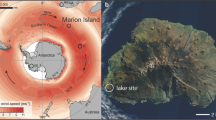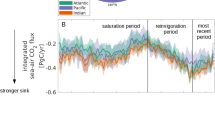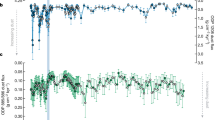Abstract
The Southern Hemisphere westerly winds (SHW) play an important role in regulating the capacity of the Southern Ocean carbon sink. They modulate upwelling of carbon-rich deep water and, with sea ice, determine the ocean surface area available for air–sea gas exchange. Some models indicate that the current strengthening and poleward shift of these winds will weaken the carbon sink. If correct, centennial- to millennial-scale reconstructions of the SHW intensity should be linked with past changes in atmospheric CO2, temperature and sea ice. Here we present a 12,300-year reconstruction of wind strength based on three independent proxies that track inputs of sea-salt aerosols and minerogenic particles accumulating in lake sediments on sub-Antarctic Macquarie Island. Between about 12.1 thousand years ago (ka) and 11.2 ka, and since about 7 ka, the wind intensities were above their long-term mean and corresponded with increasing atmospheric CO2. Conversely, from about 11.2 to 7.2 ka, the wind intensities were below their long-term mean and corresponded with decreasing atmospheric CO2. These observations are consistent with model inferences of enhanced SHW contributing to the long-term outgassing of CO2 from the Southern Ocean.
This is a preview of subscription content, access via your institution
Access options
Access Nature and 54 other Nature Portfolio journals
Get Nature+, our best-value online-access subscription
$29.99 / 30 days
cancel any time
Subscribe to this journal
Receive 12 print issues and online access
$259.00 per year
only $21.58 per issue
Buy this article
- Purchase on Springer Link
- Instant access to full article PDF
Prices may be subject to local taxes which are calculated during checkout



Similar content being viewed by others
References
Mikaloff-Fletcher, S. E. An increasing carbon sink?. Science 349, 1165 (2015).
Hodgson, D. A. & Sime, L. C. Southern westerlies and CO2. Nat. Geosci. 3, 666–667 (2010).
Toggweiler, J. R., Russell, J. L. & Carson, S. R. Midlatitude westerlies, atmospheric CO2, and climate change during the ice ages. Palaeoceanography 21, PA2005 (2006).
Le Quéré, C. et al. Saturation of the Southern Ocean CO2 sink due to recent climate change. Science 316, 1735–1738 (2007).
Landschützer, P. et al. The reinvigoration of the Southern Ocean carbon sink. Science 349, 1221–1224 (2015).
Munro, D. R. et al. Recent evidence for a strengthening CO sink in the Southern Ocean from carbonatesystem measurements in the Drake Passage (2002–2015). Geophys. Res. Lett. 42, 2015GL065194 (2015).
Ritter, R. et al. Observation‐based trends of the Southern Ocean carbon sink. Geophys. Res. Lett. 44, 12339–12348 (2017).
Lamy, F. et al. Holocene changes in the position and intensity of the Southern Westerly wind belt. Nat. Geosci. 3, 695–699 (2010).
Sime, L. C. et al. Southern Hemisphere westerly wind changes during the Last Glacial Maximum: model–data comparison. Quat. Sci. Rev. 64, 104–120 (2013).
Anderson, R. F. et al. Wind-driven upwelling in the Southern Ocean and the deglacial rise in atmospheric CO2. Science 323, 1443–1448 (2009).
Lovenduski, N. S., Gruber, N. & Doney, S. C. Toward a mechanistic understanding of the decadal trends inthe Southern Ocean carbon sink. Glob. Biogeochem. Cycles 22, GB3016 (2008).
Purich, A., Cai, W., England, M. H. & Cowan, T. Evidence for link between modelled trends in Antarctic sea ice and underestimated westerly wind changes. Nat. Commun. 7, 10409 (2016).
Wanninkhof, R. et al. Global ocean carbon uptake: magnitude, variability and trends.Biogeosciences 10, 1983–2000 (2013).
Kilian, R. & Lamy, F. A review of Glacial and Holocene paleoclimate records from southernmost Patagonia (49–55°S). Quat. Sci. Rev. 53, 1–23 (2012).
Fontana, S. L. & Bennett, K. Postglacial vegetation dynamics of western Tierra del Fuego. Holocene 22, 1337–1350, (2012).
Waldmann, N. et al. Integrated reconstruction of Holocene millennial-scale environmental changes in Tierra del Fuego, southernmost South America. Palaeogeogr. Palaeoclimatol. Palaeoecol. 399, 294–309 (2014).
Moy, C. M. et al. Isotopic evidence for hydrologic change related to the westerlies in SW Patagonia, Chile during the last millennium. Quat. Sci. Rev. 27, 1335–1349 (2008).
Bertrand, S., Hughen, K., Sepúlveda, J. & Pantoja, J. Late Holocene covariability of the southern westerlies and sea surface temperature in Northern Chilean Patagonia. Quat. Sci. Rev. 105, 195–208 (2014).
Lamy, F. et al. Antarctic timing of surface water changes off Chile and Patagonian ice sheet response. Science 304, 1959–1962 (2004).
Strother, S. L. et al. Changes in Holocene vegetation, climate and the intensity of Southern Hemisphere Westerly Winds based on a high-resolution palynological record from sub-Antarctic South Georgia. Holocene 25, 263–279 (2015).
Turney, C. S. M. et al. A 250-year periodicity in Southern Hemisphere westerly winds over the last 2600 years. Clim. Past 12, 189–200 (2016).
Vanneste, H. et al. Late-glacial elevated dust deposition linked to westerly wind shifts in southern South America. Sci. Rep. 5, 11670 (2015).
Sime, L. C. et al. Sea ice led to poleward-shifted winds at the Last Glacial Maximum: the influence of state dependency on CMIP5 and PMIP3 models. Clim. Past 12, 2241–2253 (2016).
Climate Statistics for Australian Locations, Macquarie Island (Australian Government Bureau of Meterology, 2017); http://www.bom.gov.au/climate/averages/tables/cw_300004_All.shtml
Saunders, K. M., Hodgson, D. A. & McMinn, A. Quantitative relationships between benthic diatom assemblages and water chemistry in Macquarie Island lakes and their potential to reconstruct past environmental changes. Antarct. Sci. 21, 35–49 (2009).
Röthlisberger, R. et al. Dust and sea salt variability in central East Antarctica (Dome C) over the last 45 kyrs and its implications for southern high-latitude climate. Geophys. Res. Lett. 29, 24-1–24-4 (2002).
Xiao, W., Esper, O. & Gersonde, R. Last Glacial-Holocene climate variability in the Atlantic sector of the Southern Ocean. Quat. Sci. Rev. 135, 115–137 (2016).
Ferry, A. J. et al. First records of winter sea ice concentration in the southwest Pacific sector of the Southern Ocean. Paleoceanography 30, 1525–1539 (2015).
Bianchi, C. & Gersonde, R. Climate evolution at the last deglaciation: the role of the Southern Ocean. Earth Planet. Sci. Lett. 228, 407–424 (2004).
Jouzel, J. et al. Orbital and millennial Antarctic climate variability over the past 800,000 years. Science 317, 793–796 (2007).
Masson, V. et al. Holocene climate variability in Antarctica based on 11 ice-core isotope records. Quat. Res. 54, 348–358 (2000).
Fletcher, M.-S., & Moreno, P. I. Zonally symmetric changes in the strength and position of the Southern Westerlies drove atmospheric CO2 variations over the past 14 k.y. Geology 39, 419–422 (2011).
Moreno, P. I. et al. Onset and evolution of southern annular mode-like changes at centennial timescale. Sci. Rep. 8, 3458 (2018).
Prebble, J. G. et al. Evidence for a Holocene Climatic Optimum in the southwest Pacific: a multiproxy study. Paleoceanography 32, 763–779 (2017).
Röthlisberger, R. et al. EPICA Dome C Ice Core nss-Ca and Na Data. IGBP PAGES/World Data Center for Paleoclimatology Data Contribution Series #2005-046 (NOAA/NGDC Paleoclimatology Program, 2005).
Monnin, E. et al. Atmospheric CO2 concentrations over the Last Glacial Termination. Science 291, 112–114 (2001).
Brovkin, V. et al. Comparative carbon cycle dynamics of the present and last interglacial.Quat. Sci. Rev. 137, 15–32 (2016).
Stocker, B. D., Yu, Z., Massa, C. & Joos, F. Holocene peatland and ice-core data constraints on the timing and magnitude of CO2 emissions from past land use. Proc. Natl Acad. Sci. USA 114, 1492–1497 (2017).
Saunders, K. M. et al. Ecosystem impacts of feral rabbits on World Heritage sub-Antarctic Macquarie Island: a palaeoecological perspective. Anthropocene 3, 1–8 (2013).
Bracegirdle, T. J., Hyder, P. & Holmes, C. R. CMIP5 diversity in southern westerly jet projections related to historical sea ice area: Strong link to strengthening and weak link to shift. J. Clim. 31, 195–211 (2018).
Wolff, E. W. et al. Southern Ocean sea-ice extent, productivity and iron flux over the past eight glacial cycles. Nature 440, 491–496 (2006).
Bracegirdle, T. J. et al. Assessment of surface winds over the Atlantic, Indian, and Pacific Ocean sectors of the Southern Ocean in CMIP5 models: historical bias, forcing response, and state dependence. J. Geophys. Res. Atmos. 118, 547–562 (2013).
Köhler, P., Fischer, H., Munhoven, G. & Zeebe, R. E. Quantitative interpretation of atmospheric carbon records over the last glacial termination. Glob. Biogeochem. Cycles 19, GB4020 (2005).
Chavaillaz, Y., Codron, F. & Kageyama, M. Southern westerlies in LGM and future (RCP4.5) climates. Clim. Past 9, 517–524 (2013).
Rojas, M. Sensitivity of Southern Hemisphere circulation to LGM and 4 × CO2 climates. Geophys. Res. Lett. 40, 965–970, (2013).
Van Nieuwenhuyze, W. Reconstruction of Holocene Paleoenvironmental Changes in the Sub-Antarctic Region. PhD thesis, Univ. Ghent (2015).
Davies, S. J., Lamb, H. F. & Roberts, S. J. in Micro-XRF Studies of Sediment Cores (eds Croudace I. W. & Rothwell R. G.) 189–226 (Springer, Dordrecht, 2015).
Heimburger, A., Losno, R., Triquet, S. & Nguyen, E. B. Atmospheric deposition fluxes of 26 elements over the Southern Indian Ocean: time series on Kerguelen and Crozet Islands. Glob. Biogeochem. Cycles 27, 440–449 (2013).
Butz, C. et al. Hyperspectral imaging spectroscopy: a promising method for the biogeochemical analysis of lake sediments. J. Appl. Remote Sens. 9, 096031 (2015).
Acknowledgements
This research was funded by NERC Standard grant NE/K004514/1 (D.A.H., S.J.R., L.S.), Swiss National Science Foundation Ambizione Postdoctoral Research Fellowship PZ00P2_136835/1 (K.M.S.), Swiss National Science Foundation Grant 200021_172586 (M.G.) and Australian Antarctic Science grants 3117 and 4156 (K.M.S.). K.M.S. was also supported by PhD funding as part of grant 2663 to A. McMinn, an Australian Postgraduate Award (2004–2008) and an Australian Institute of Nuclear Science and Engineering Postgraduate Research Award. The Australian Antarctic Division and the Parks and Wildlife Service Tasmania provided logistical support and access to the Macquarie Island World Heritage Area. Field support was provided by A. O’Hern, A. Wakefield, C. Oosthuizen, B. Arthur, J. van Dorst, J. Pitcher, S. Williams, T. Blyth and Parks and Wildlife Service Rangers and volunteers. We thank H. Lu of the British Antarctic Survey for providing and adapting MATLAB scripts for sequential Mann-Kendall test analyses, A. Whittle for processing the wind data and underlying geotifs in Fig. 1a and b, and D. Fischer, S. Arcusa and N. Tunstall for technical support.
Author information
Authors and Affiliations
Contributions
D.A.H., K.M.S. and S.J.R. contributed equally to this work. Fieldwork was carried out by K.M.S., D.A.H., S.J.R. and W.V.N. Analytical work was performed by S.J.R. (μ-XRF, sedimentology, chronology and statistical analyses) and S.D. (μ-XRF), K.M.S. and B.P. (D-I conductivity analyses, chronology and sedimentology), W.V.N. (fieldwork and diatom analysis), K.M.S., C.B. and M.G. (hyperspectral imaging) and L.S. (modelling). D.A.H., K.M.S., S.J.R. and B.P. wrote the manuscript and Supplementary Information with input from all authors.
Corresponding author
Ethics declarations
Competing interests
The authors declare no competing interests.
Additional information
Publisher’s note: Springer Nature remains neutral with regard to jurisdictional claims in published maps and institutional affiliations.
Supplementary information
Supplementary Dataset 1
Data for Fig. 2.
Supplementary Dataset 2
Data for Fig. 3.
Rights and permissions
About this article
Cite this article
Saunders, K.M., Roberts, S.J., Perren, B. et al. Holocene dynamics of the Southern Hemisphere westerly winds and possible links to CO2 outgassing. Nature Geosci 11, 650–655 (2018). https://doi.org/10.1038/s41561-018-0186-5
Received:
Accepted:
Published:
Issue Date:
DOI: https://doi.org/10.1038/s41561-018-0186-5
This article is cited by
-
Uncovering the world’s largest carbon sink—a profile of ocean carbon sinks research
Environmental Science and Pollution Research (2024)
-
Radiocarbon evidence for the stability of polar ocean overturning during the Holocene
Nature Geoscience (2023)
-
Stable Southern Hemisphere westerly winds throughout the Holocene until intensification in the last two millennia
Communications Earth & Environment (2022)
-
Holocene melting of the West Antarctic Ice Sheet driven by tropical Pacific warming
Nature Communications (2022)
-
Hydrochemical and isotopic baselines for understanding hydrological processes across Macquarie Island
Scientific Reports (2022)



